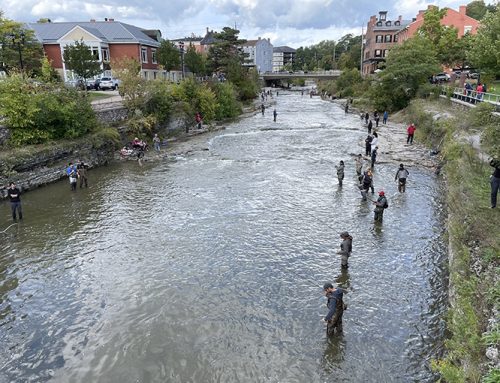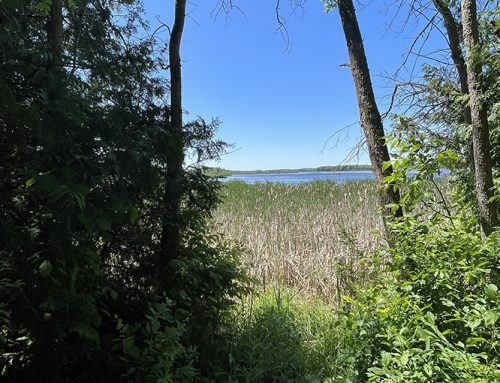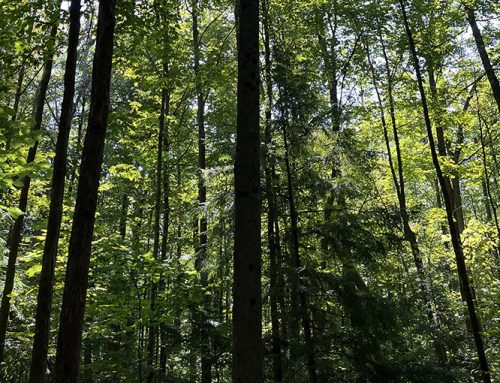
The Ontario Ministry of Natural Resources released the 2014 moose tag quotas and guarantees for group sizes yesterday and it’s bad news — for hunters and for moose.
This winter’s aerial surveys showed that moose populations in some areas of Ontario have declined, so the MNR has reduced moose tags across the province by about 18% for 2014.
Some of the biggest changes are happening in the following wildlife management units:
| WMU | Bull Tags 2014 |
Cow Tags 2014 |
Total 2014 |
Total 2013 |
Difference |
| 05 06 08 13 15B 28* |
63 12 12 55 463 16 |
65 9 12 70 377 14 |
128 21 24 125 840 30 |
413 40 205 1,115 1,282 457 |
-285 -19 -181 -990 -442 -427 |
The reasoning
When changes this large are made, people ask why — and sometimes — come up with their own theories. The MNR based the changes on data gathered from aerial surveys. Here is a summary of those results.
Northwestern Ontario
Surveys were done in nearly half—14 of the 30—of the WMUs in this region and the results showed populations to be stable in 5 areas, stable-to-decreasing in 3 areas, and decreasing in 5 areas. Notable decreases were seen in WMU 5 and 8 in Dryden District, 14 in Nipigon District, 13 in Thunder Bay District and 9B and 11A in Fort Frances District.
Northeast Ontario
Aerial surveys were flown in 7 of the 27 WMUs and moose populations are estimated to be stable in only 1 of those areas and decreasing in 6. Decreases were seen in WMU 23 in Hearst District, 28 in Kirkland Lake District, 32 in Wawa District, 35 and 36 in Sault Ste. Marie District and 41 in North Bay District. The population is stable for 39 in Sudbury District.
Impact on guaranteed group sizes
Since tag allocations and group size guarantees are directly linked to moose populations, there are a number hunting groups that will not be guaranteed a tag this year. For example, in WMU 8 groups larger than 3 that gun hunt for mooose were guaranteed a bull tag and a cow tag in 2013. This year, there are no guarantees in that area. Similar changes have been made to other areas as well.
“While this is not encouraging news for moose hunters, it does present the opportunity to re-evaluate how we share in the management of the moose resource,” said John Kaplanis, executive director of the Northwestern Ontario Sportsmen’s Alliance. “We would like to work cooperatively with the Ministry of Natural Resources to investigate this trend and subsequently make changes to manage moose, with confidence that this declining trend can be turned around.”
Good news for Southern Ontario
Aerial surveys flown in 4 of 15 WMUs landed positive news. Moose populations were estimated to be stable to increasing in all surveyed units in this region.
“Ontario and its partners have agreed that we must act now to secure the future of moose in this province,” said Minister of Natural Resources David Orazietti. “Moose are not only important to Ontario’s economy, particularly in northern communities, but they are also vital to our province’s biodiversity.”
Get full information on changes to the moose hunt here.







So now i have to pay 50$ for a chance at one of 30 tags??? think I will just by 6 49 tickets….
doesn’t bear kill more moose than hunters? we will be over populated with bears because of the cancellation of the spring bear hunt. anyone with a license can kill a calf? I think the ministry is making a grave mistake with these new rules. Northern Ontario economy depends on this sport every fall. Looks like the government is trying to stop the economy in the north which is not the best anyways. Let the bears get the young moose and populations will be down even more than it is now. Has anyone looked at the possibility, for the declining moose population may have something to do with cancelling the spring bear hunt? This is a drastic step and will have a large impact on the tourism in Northern Ontario. Outfitters who depend on this economy will be closing and then Ministry of Tourism will wonder why? A lot of these hunters return to the north in the summer with their families. Now we won’t have hunters coming this fall. Licenses will be down as a lot of hunter won’t shoot calves and with few tags for Zone 28 who wants to pay for the license when the chances of getting a tag is next to none.
yes ,,,,as a guide we all want to see the moose numbers go up ,,with the spring bear hunt under way ,,i think it will happen
One of the ripple effects of all this bs is that people tend to flood the areas with greater chances of tag success and all populations get hit birds fish moose. We all need to look at how most of us hunters are ethical and just want a fair opportunity to do what we love with a reasonable chance of success without being over crowded or destroying a population. We as hunters brought back the wild turkey, the elk supported many habitat rehabilitation projects for fish birds and wildlife it is a shame our government won’t put forth the knowledge and effort that we as a group have done for many years. Fix the problem not the blame.
I sent a lengthy letter last year concerning native abuses of hunting laws last year. What I personally witnessed was 9 bull moose in area 29 (canoe shed south of Timmins 50 miles) being taken by native hunters in 3 newer 4×4 club cab vehicles hunting at night and in the dark with lights. They would come back at daybreak to claim their kills if they were dead. I personally saw this and reported it. I was told nothing could be done without proof, so this year I will have a camera mounted in my vehicle and tape recorders at the ready. The ministry should be the ones doing this not me. The natives in question are not the most friendly people around and don’t and wont appreciate my efforts. This year I will have to bow hunt with some hunter orange on in fear of being shot in the low light from a new truck if you get my drift. This is a big reason the moose numbers are down and in area 28 are being slashed. The population of moose are being slaughtered by by mother earths native people and not with traditional bows and arrows but the most modern equipment that Canadian money can buy. Lets all stand up and be counted and let the powers to be know that we are sick of this bowing down to the abusers of the system.
It is the number one problem and the OFAH refuses to speak out against it
The OFAH did mention aboriginal harvest in their list of factors requiring more consideration by the mnr. I agree with Rob, this BS about the natives being stewards of the land needs to end. Their harvest rates need to be monitored and regulated like everyone else or the resource is toast. Look at the Walleye in Nippising. Non-natives don’t stand a chance of catching one meanwhile the natives operate a commercial net fishery on that lake. Its insane.
Yes a factor requiring more consideration is not really speaking out against it. We need to be more firm about non-regulated harvesting of our resources.
where i went hunting last year in 18a there where 25 moose shot before opening day.They were sell them in the village for 500 dollars.we drive 18 hours
rob I hunted that area extensively last year and for the last 4 years and the only native folks I saw were the trappers. I did however see a group of non natives who were dealing with mnr after shooting the wrong moose and that was the 4th time in 4 years that situation has occurred. the problem in that area is the extreme overpopulation of wolves and bears, they seem to be having a field day with moose. the wolves especially are really increasing in number.
I seen the same thing on opening day in area 31 just west of timmins. Found two moose dead in a cut, then two native dudes showed up with a brand new Argo, asking me if i saw the two moose they shot the day before, one day out of season. I told them they were not Stewarts of the earth, but blatant wildlife poachers!
I am happy for you that you feel comforted blaming the natives for a problem we have all contributed to. Sleep well with your delusions.
you really are an idiot
It is not all the natives fault for sure anyone who buys a moose or any other game from a native is supporting the illegal killing of wildlife and is just as guilty. In Geraldton where I have bow hunted moose for many years I was informed of a local native opp officer who shot and sold 10 moose in 2014 nice extra income for 1 and detrimental to populations and to the rights of the rest of us including those hunters purchasing them for what? Bragging rights? I ran into the same issues in Horn Payne many years ago and it went from two 1st round applications to 9 in one year. For a bow tag! Ridiculous! I also called the MNR about illegal night hunting there the first question I was asked was were they native? When my response was yes the conversation was over.
What did the politicians think was going to happen when they cancelled the spring bear hunt. In the area I hunt I never saw a bear years ago, now bears is all I see, what chance does a calf have against 400lb plus killing machines that can smell newborns a mile away and run as fast as a race horse. The moose numbers are dropping in the parks as well. So you know its not the hunters fault. I can not believe the ministry does not know where the problem lies. Try this, find bear scat if moose hair is present problem solved. Getting the politicians to admit they screwed up might be a little more difficult.
How many votes does it buy me and at what cost, not a billion dollars , not worth our time
where are all the comments?
bears kill more moose than hunters. And they didn’t bring back the spring bear hunt in this area. Now we will be overrun with bears and they will be the ones killing the moose. This decision was not made with any sense. with our thick bush landscape tell me how you can count moose from the air? They are trying to kill tourism and hunting in the north. There will be many outfitters closing their doors and moose season was the busiest time of year. The northern economy will suffer greatly.
Had to happen eventually, can’t keep watching the population go down and do nothing.
OFAH condemns cuts to moose tags
http://www.ofah.org/news/MNR-slashes-moose-hunting-opportunities
Imagine the poor liberals coffers if the hunters decide not to buy a licence until this is fixed. Maybe it should be a $10 entry fee for the draw and then if you are drawn then a $200 licence with four licence per moose. Save buying all those extra tags for to try and meet quota.
How has Quebec managed all these years with their system and Ontario hunters are going there. If we are in declining numbers then why not bulls only for 10 years?
Is their any rumour to the fact that in 21A they are trying to eradicate the moose for caribou or elk?
I have been an outdoorsman for over 40 years and I am in the bush allot in northern ontario I have seen many times were MNR are in the bush on the ground not once have I ever seen a helicopter or a plane counting moose in any season so when they say the count is down this bogles me can anyone say that they have seen them doing a count? this is all propaganda
Well I say eliminate forestry operations and all their access roads to the bush and see how things go. I remember in through the 60’s most hunters from the “south” that would come up to hunt in areas like zone 28 and adjacent zones would hire a aboriginal guide because there success rate would be very “low left to their own means”. These hunters could not come up and drive out into the hunt zone and wait in a wide open cut block like today and bag a moose, “you actually had to hunt”. Even the Famous Ellwood Epps used guides here till he got to know the territory. And don’t be silly I know most local hunters did not need a guide in these times. And if you can remember when the draw system started, it seems to coincide with newer larger sawmills and clear cuts that had started to happen at this time. Just Saying.
Highwater their playing with us, check the stats I listed below. Also 12 Pulp & Paper Mills have closed, which means NO more forestry operations. Add all the saw mills, plywood & strandboard mills that have closed. BUT new growth in clear-cuts generates more feed which moose love. About access roads most forestry companies were given Tax-Dollar$$ for Road Building. I am against closing roads. That was actually a strategy of tourist Outfitters, close roads and have more private hunting grounds all to themselves & their customers.
why not do it like they do in New Bruswick you apply and if they pick your name then you buy you license they only open the season for a short time and it seem to be working just fine.
Back to the fishing thread, although all of us need to be more responsible stewards of the earth and use renewable clean energy / recycle / reuse etc, I was sad to learn that some First Nation people were netting in local lakes and when they do not like the kind of fish the nets caught, they do not take the time to free the fish or untangle the net, they just throw the whole net away with all the fish. Another sad story is when nets are left unchecked for months, thousands of fish die. Netting should be abolished, along with three-pronged lures. All quotas should be reduced to help protect fish. One fish/person makes more sense than five/person for any species. Netters often observe professional fisherpeople and after the pros leave then nets are placed at night, or where fish congregate for spawning, this should be forbidden. In Whitefish Falls Ontario during the walleye spawning season, there are people spearfishing walleye using flashlights to attract them. There are more stories, but we should all remember and practice fair labor, land, employment, education and healthcare (like mental wellness) rights in order to help everyone realize their own potential equally and fairly. 50% of earth’s animals have disappeared in just 40 years (!!!) let’s keep Canada great by rigorously protecting wildlife and forests. When the first nations claim being here for 20,000 years which is true, preserving hunting traditions means no 4x4s, flashlights, or guns, it means hauling away animals by hand. We are all one people on one earth with one living eco-system, hunger is a reality, and so is responsible wildlife harvest as well as human population management.
I am in 28 hunting calves and we have never seen so many moose. You won’t find mouse at the airport. Reduce cow tags, eliminate cost of Wolfe tags (seen 6 on two days) and bring back the spring bear hunt.
The ministry is useless!!!!!!
Was told of a trailer full of Metis harvested moose at a Meat processing shop in Haggar! This is probably a situation called not reporting a harvest! That is where all the moose is going or maybe a good percentage of them!
Hello . . . interesting comments all around . . . looking for a responsible 2 persons
for a moose hunt – better late than never – I have a bull tag for 16A – Pickle Lake, Ontario
– need just about everything to make this happen including accommodation . .
* straight – serious hunters, that like to hunt, fish, and make it happen – . ..
* one good hunter would do it, but needed accommodation such as trailer ect would work out better . . . .
* all we need is one or two experienced hunters . .
Any ideas out there . . . Best . . Brian . . 905-348-6133 . . . . 6:45 PM EST
Still looking 1 – hunters for 16A – Pickle Lake, experienced preferred but will discuss
with dedicated persons that are willing to learn . . See below at next discussion.
Thanks . . . Brian 905-348-6323 .
MNU 47 moose tags dropped from 102 last year to a total of 12 in 2015.
Why buy a license?.
So much for the good news for Southern Ontario.
Why purchase a Moose tag, Moose season in Ontario should be closed down for 2015. if there isn’t any Moose. And no Non-Resistant hunters allowed,
not sure what’s going on. WE should cancel Moose for 2015 if there are no Moose. why pay $55. for nothing
hello you hunt wmu 28 can you tell me where to find how many application there were for the 30 tags in 2015
looking for Moose hunters to join well established Moose camp. looking for responsible hunters, age group know is 45-55 range.
I suggested to the MNR 3 years ago to cancel all moose hunting until the populations increase to an acceptable level! I have not and will not apply for a tag until this happenstance!
I think that calf hunting is almost as ridiculous as cow hunting they should provide a immature bull tag for everyone spike horn or fork horn and then have a draw system for mature bulls 50 inch or better! And to any Joe whitey that buys a moose deer fish or anything else from a native quit your messing it up for everyone especially the animals!
Wyatt
moose tags for 2019 area 50